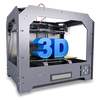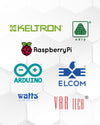
The Evolution of Electronic Components Over the Decades
If you could hold a vacuum tube in one hand and a microcontroller in the other, you'd be physically holding the history of electronics. From bulky glass tubes to fingernail-sized chips that power satellites, the evolution of electronic components has been one of humanity’s most transformative technological journeys.
Whether you're a student, hobbyist, or seasoned engineer, understanding where components came from can deepen your appreciation for the tools we now have and maybe even spark ideas for where we’re heading.
1940s–1950s: The Age of Vacuum Tubes
Long before transistors and microchips, electronic circuits ran on vacuum tubes. These large, heat-emitting devices were used to amplify signals in early radios, TVs, and the first computers like the ENIAC.
-
Pros: Enabled amplification and switching
-
Cons: Huge, fragile, power-hungry
While vacuum tubes were groundbreaking for their time, they were impractical for miniaturization. That would soon change...
1950s–60s: The Rise of the Transistor
A major change occurred in 1947 with the development of the bipolar junction transistor (BJT). By the 1950s, transistors began replacing vacuum tubes in radios, calculators, and hearing aids.
Transistors were:
-
Smaller
-
Faster
-
More energy-efficient
-
Longer-lasting
Today’s descendants of those early devices include NPN and PNP transistors, still used in switching, signal processing, and power regulation.
1960s–70s: Enter the Integrated Circuit (IC)
Consider putting several transistors, capacitors, and resistors on a single silicon chip. That was the magic of the integrated circuit, which made mass production of complex electronics possible.
ICs revolutionized:
-
Consumer electronics (TVs, radios)
-
Military and space systems
-
Computers and industrial controllers
Popular ICs like the 555 Timer (invented in 1972) remain in use to this day for timing and PWM control.
1970s–80s: Microprocessors & Memory Modules
With ICs came the first microprocessors — full CPUs on a single chip. Intel’s 4004 in 1971 kicked off a revolution in computing.
This era brought:
-
Personal computers (Apple I, Commodore)
-
Early gaming consoles
-
Digital calculators and watches
RAM, ROM, and EEPROM chips also matured during this time, making programmable electronics possible.
👉 Shop Microcontrollers & Memory ICs
1980s–90s: Solid-State & Surface Mount Devices (SMD)
While traditional through-hole components dominated early designs, the electronics industry began shifting to surface mount technology (SMT) for speed and space savings.
SMD components enabled:
-
Compact PCBs
-
Mass production via pick-and-place machines
-
Lighter, more efficient devices
Today, you’ll find SMD versions of nearly every component — resistors, capacitors, transistors, and even MCUs.
1990s–2000s: Rise of Wireless and Embedded Systems
As mobile phones and early IoT devices emerged, components needed to be even smaller, smarter, and more power-efficient.
This period saw the rise of:
-
Bluetooth and Wi-Fi modules
-
Embedded microcontrollers with built-in peripherals
-
Low-dropout voltage regulators
-
Battery management systems
Notably, DIY culture grew thanks to open-source boards like the Arduino Uno, released in 2005, making embedded development accessible to everyone.
2010s–Now: IoT, Sensors, and Smart Everything
The 2010s ushered in the age of IoT. Sensors became cheaper, microcontrollers gained wireless capabilities, and entire ecosystems like ESP8266 and ESP32 emerged.
Today’s electronics integrate:
-
Smart sensors (temperature, gas, motion, soil, etc.)
-
Wireless modules (Wi-Fi, BLE, LoRa)
-
Touch displays & OLEDs
-
Rechargeable lithium battery packs
These devices are not just reactive but context-aware, able to process, decide, and communicate in real time.
What’s Stayed the Same?
Despite all this innovation, some things haven’t changed much:
-
Resistors still limit current
👉 Buy Resistor -
Capacitors still smooth power and handle timing
👉 Explore Capacitors -
Diodes still direct current and prevent reverse voltage
👉 View Diodes Collection
Even in today's high-frequency, high-speed digital world the building blocks remain the same.
What's on the Horizon?
Looking ahead, electronic components are becoming:
-
Flexible (printed on plastic or fabric)
-
Self-powered (energy harvesting)
-
AI-enhanced (edge computing)
-
Smaller and smarter than ever before
We’re also seeing breakthroughs in quantum components, photonic chips, and biocompatible circuits for wearable health monitoring.
What This Means for DIY Builders
As a student or hobbyist, you now have access to:
-
More powerful modules at lower prices
-
Better documentation and tutorials
-
Cross-platform tools (Arduino, Python, Node-RED)
-
Plug-and-play sensors and breakout boards
You don’t have to solder a hundred resistors to build a clock anymore but you can if you want to!
👉 Explore Beginner Kits & Tools
Final Thoughts: From Tubes to Smart Sensors
In just 80 years, we’ve gone from room-sized computers to voice-controlled assistants the size of your palm. The evolution of electronic components isn’t just about miniaturization it’s about accessibility, creativity, and possibility.
And today, you have more tools at your fingertips than ever before. So whether you're recreating a retro circuit or experimenting with AI-powered sensors, remember: every great innovation started with a handful of humble components.
👉 Shop Modern Electronic Components at Tomson Electronics
Let’s keep building the future one resistor, one microcontroller, and one idea at a time.



